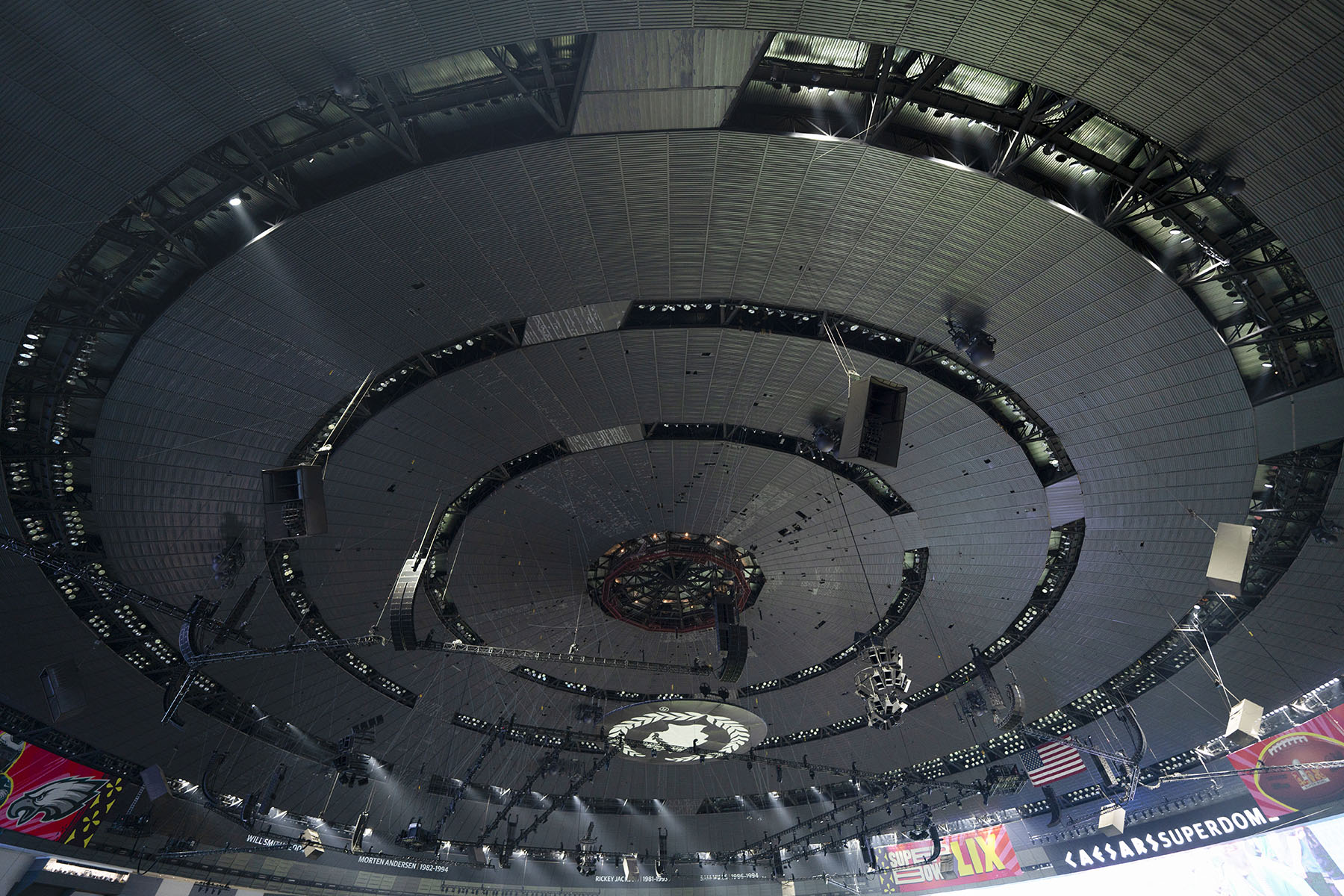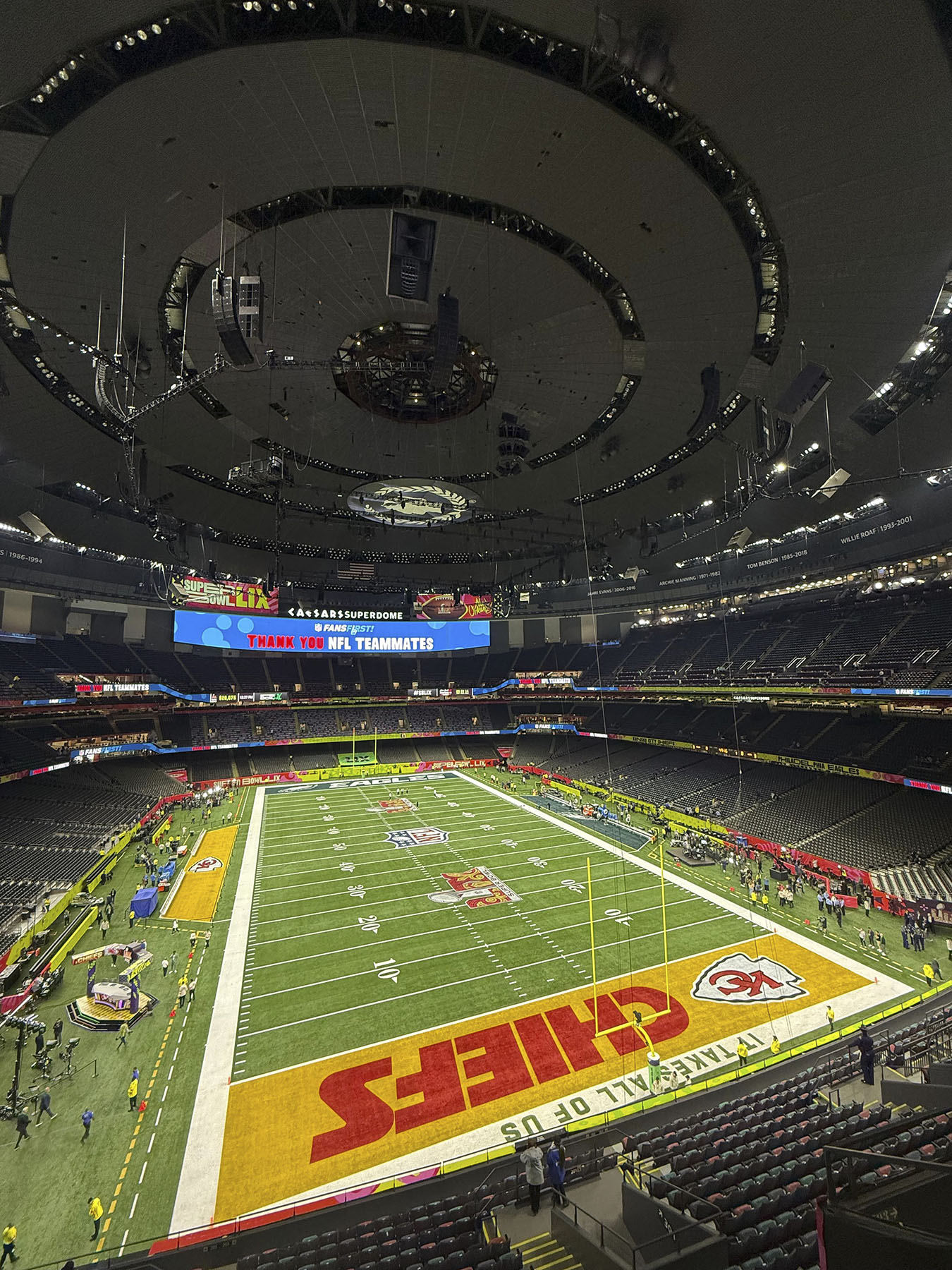The Caesars Superdome in New Orleans hosted this year's Super Bowl LIX, the eighth time the venue has played host since it opened in 1975. Whether serving as a home to the New Orleans Saints or a main refuge during Hurricane Katrina, the Dome’s survival over the years has become a powerful symbol of the city’s resilience and determination to rebuild and thrive. And so has its sound, powered by an L-Acoustics sound system.
This year's Super Bowl, which included the now much-discussed halftime show from 22-time Grammy Award winner Kendrick Lamar, brought in a completely new sound system: an L-Acoustics K2-based system, provided by ATK Audiotek/Clair Global, who have managed the halftime-event sound for nearly 30 years.
The system comprised 16 hangs of K2 arrays and eight hangs of KS28 subs. A dozen of those K2 hangs had K1-SB above; eight of the K2 hangs had closely-coupled K1-SB, while four of the remaining K2 hangs used K1-SB as a line extension. The number of subs has been increasing over the last few years, reflecting the halftime shows’ production by Jay-Z’s Roc Nation company, which has steered the events in a hip-hop direction since 2019.
[How AI Is Going to Change Sports]
It is the third time that Kirk Powell, design engineer at ATK Audiotek (acquired in 2021 by Clair Global) and his staff—including show mixers Alex Guessard and Dave Natale, monitor mixers Tom Pesa and Chris Daniels, and systems engineer Johnny Keirle—have put a separate sound system up in the air in a Super Bowl venue. That process began two years ago, when State Farm Stadium’s roll-out grass field prevented the carts that had been deployed for decades to trundle PA components quickly out to the field for the changeover to Usher’s halftime show. Until 2023, the halftime-dedicated sound systems were used exclusively for the music performances, with the installed house PA used for announcements and effects sound.

Since then, the temporary L-Acoustics PA systems have also handled all of the live sound in the bowl for the game and all related events, such as the Opening Night event at the stadium on Monday, where hundreds of media interview Super Bowl players and coaches for the first time during their only public appearance before taking the field for The Big Game. But because this year the temporary system was also being used for the entire game, there were actually a total of 200 K2, 40 K1-SB, and 64 KS28—the largest such system yet deployed of any type for a Super Bowl. It also served as the first-listen opportunity ahead of the game and halftime events, as well.
“The halftime show is so different than what we’re doing for opening night, but we get a good handle on how the room feels,” Powell said. “Having a flown system makes a lot of difference because the coverage is better and it’s consistent – it’s there all day; we’re not moving it in and out during rehearsals. It’s the third time we’ve done this and it’s a continuation of just trying to improve and tweak and see if we can make it a little bit better than last time.”
[Check Out How the Cosm Dome Is Reinventing Watching Sports]
Super-Challenging Dome Design

The Superdome—the fifth oldest in the league and the second-ever domed NFL field—is a relic from an earlier era of stadium architecture and a living historical record of sound-system design. “It’s got really deep under-balconies and that creates a big challenge,” said Powell. “You have to rely on the installed house system for the fill speakers you need to reach those areas. And acoustically speaking, there are other challenges, because it’s an older stadium that wasn’t updated like a newer stadium would be for acoustic treatments to address, for instance, the reflectivity of a lot of exposed concrete. Plus, it’s a big, roofed room. So yes, there are acoustic issues.”
But the L-Acoustics K Series was more than up to the challenge. “One of the biggest challenges was the trim height restriction, as no rigging elements could be lower than 153 feet from the field,” explained PA systems designer Johnny Keirle. “That forced me to design the system higher than ideal, which introduced coverage and tonal balance challenges, as well as potential temporal issues. The flexibility of the K Series, particularly K2’s adjustable Panflex and rigging flexibility, was key in combatting these constraints. Narrowing the horizontal dispersion of the K2 using Panflex, and using K2 rigbars to allow for extreme curvature where needed, helped to both maintain coverage and tonal consistency despite the higher-than-optimal trim requirements.” Further, he added, L-Acoustics’ Soundvision design software allowed for fast and accurate on-site optimization of the designs.
[L-Acoustics Provides Stadium-Wide Sound at Boise State’s Albertsons Stadium]
The event’s music component was substantial—in addition to the Kendrick Lamar halftime show, Louisiana jazz legends Jon Batiste and Trombone Shorty with singer Lauren Daigle also performed live—and the K Series assured they all had a great show. “With K Series, rather than having a public address-type system, I can design a system that delivers a true rock and roll experience, not just for the halftime show, but also for pre-game entertainment and the game itself,” said Keirle. “Both elements of the event – the game announcements and the halftime show—have different criteria, and I approached the system design with both in mind from the start. The system was designed to deliver plenty of SPL and LF contour for the halftime show to hit with impact, while maintaining the clarity, intelligibility, and immediacy required for game announcements and referee calls.”
The game had an unexpected ending: a lop-sided score that saw the Philadelphia Eagles prevent the Kansas City Chiefs’ widely predicted three-peat win. But what everyone got was a superb sonic experience via the L-Acoustics K Series arrays. “Everything went just as fantastic as we expected,” Powell concluded. “We had plenty of headroom with the L-Acoustics system all night long, and it sounded great for both the halftime show and the game itself. It was a win.”